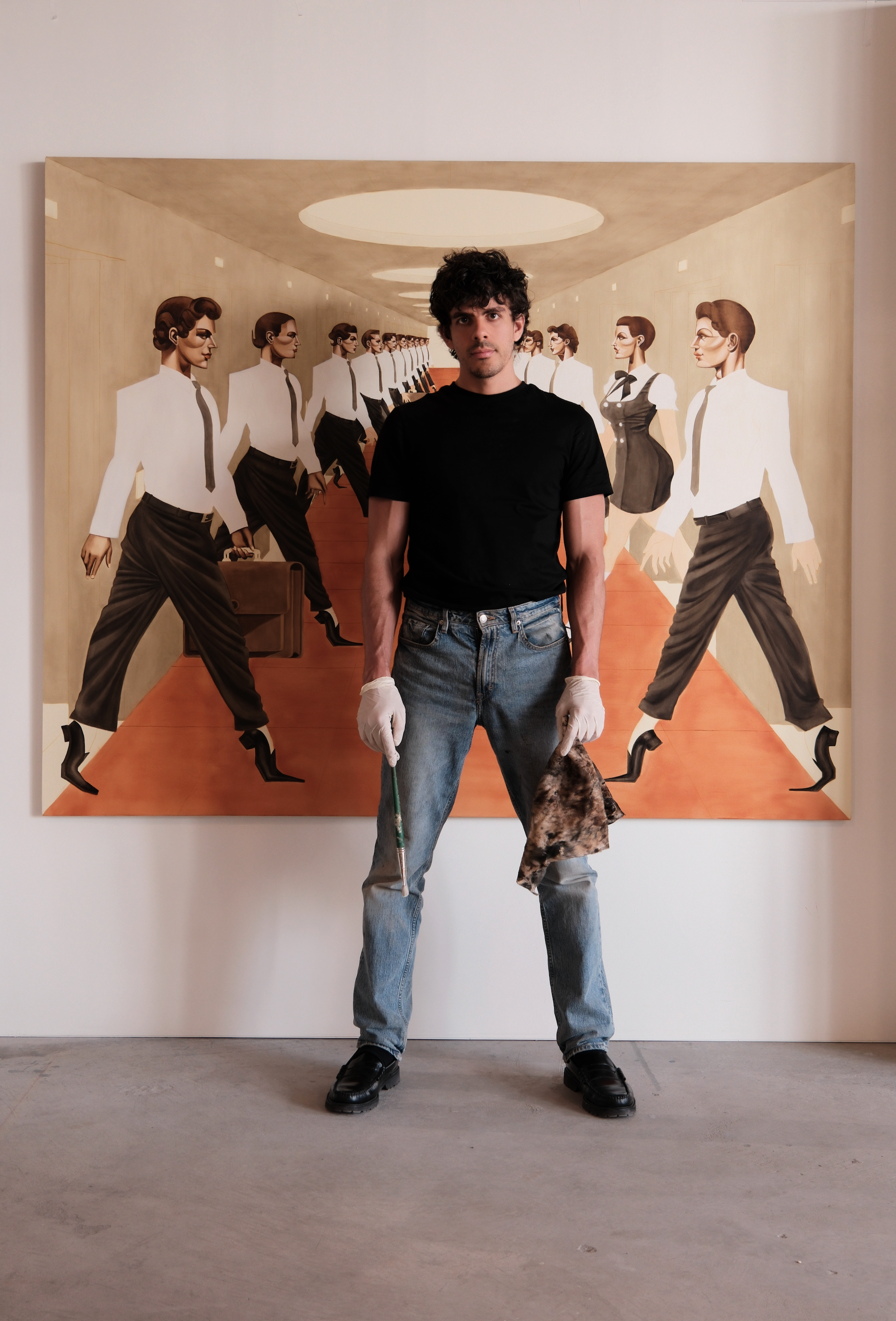
“Day-to-night” looks—ensembles that can transition from smart office attire to a night-on-the-town look with just a few adjustments—are a longstanding hallmark of glossy magazine pages. These popular columns seemed to agree: the professional and the personal selves are distinct identities—with distinct attires.
New York artist Jean-Pierre Villafañe turns this logic on its head with a series of irreverent new paintings now on view in “Playtime” at Charles Moffett, his debut solo exhibition with the gallery (on view through August 2, 2024). Here, Villafañe imagines corporate corridors, where androgynous figures masquerade in ensembles that mix professional suits and burlesque with a kind of seamless ease.
Jean-Pierre Villafañe, Clocking-In (2024). Photo: Andy Romer. Courtesy of the artist and Charles Moffett.
“I’m looking at the idiosyncratic personalities of New York City,” said Villafañe at his studio at Silver Art Projects, a residency at the World Trade Center in New York, with a panoramic few of Lower Manhattan visible behind him. ”
This series is about the banker who wears drag at night, an anesthesiologist who gets obliterated with alcohol, a lawyer who is at nightclubs til dawn and then goes to the courtroom. These are people who are transforming their identities in extreme ways.”
In one painting, Clocking-In (2024), office workers file into a hallway cinematically, but here button-downs are paired with black stiletto pumps, red rouge, or a fitted black pinafore. It’s a Mad Men-meets-Chicago kind of image. Other times the scenes feel a bit sinister, bringing to mind the work of New Objectivity artists like Otto Dix. Reds, whites, and blacks dominated these images—but also beige tones, that hint at muted office decor and glare of overhead lighting.
Portrait of Jean-Pierre Villafañe. Courtesy of Charles Moffett.
Villafañe says he is fascinated by the tensions between the places where we spend our work lives and the corners where we indulge our darkest desires. Born in Puerto Rico, Villafañe grew up painting but trained as an architect, After earning his Master’s degree in architecture at Columbia University in 2019, he spent just a few weeks working in an architectural office before realizing he wanted to devote himself to painting. And then 2020 happened, Villafañe found himself observing the morphing of selves in real-time.
“That was a time when we were very much confined to the home. The domestic space was becoming a public space at the same time—it was absorbing the office, the school, the discotheque, restaurants—a little bit of everything,” he recalled. In the years since Villafañe believes the culture of office life has shifted irrevocably, with identities once closely guarded have had slippage. “The architecture of the city around us is performing too,” he said.
His paintings of these murky identities have quickly garnered the art world’s attention. He’s exhibited internationally with Diablo Rosso from Panama City, Embajada in San Juan, and Galerie Hussenot in Paris. His 2023 presentation with Embajada at the Armory Show in New York was awarded the TPC Art Finance Prize.
Jean-Pierre Villafañe, Playtime (2024). Photo: Andy Romer. Courtesy of the artist and Charles Moffett.
In his most recent paintings, the landscape of Lower Manhattan plays a particular role. “There’s an issue in the city right now where affordable housing is being replaced by a lot of luxury condominiums and high rises,” he explained. “The city is making space for the rich: the banker, the lawyer, the doctor.” In his paintings, the architecture of the city acts almost as a stage set on which these characters perform their not-always-flattering personas. In Offsite (2024) depictions of spires and cupolas of various urban architecture form a pictorial frame around a tangle of half-nude figures. The artist notes his passion for the paintings of Italian Renaissance artist Piero della Francesca, who was famed for his embrace of geometric forms and perspective, when considering his own compositional strategies.
Jean-Pierre Villafañe, Offsite (2024).Photo: Andy Romer. Courtesy of the artist and Charles Moffett.
Carnival, dance, and Puerto Rican festivals also obliquely inspire Villafañe’s imagery. The artist’s other was a salsa dancer, and he grew up attending professional dance competitions, giving him a particular sensitivity to arrangements of limbs in space. “I am very conscientious of the edges of paintings. Everyone is choreographed around these boundaries,” he noted. The Feast of San Sebastian which takes place in San Juan every January, he says, also comes into play here in his treatment of the professional classes.
“During this festival, we satirized all these governors, bankers, and lawyers—the people who control the country,” he said. “Artisans make sculptures out of these figures. A lot of music was involved, traditional music from the island, like salsa but also our African roots. Everything is intertwined into our metizo culture which has roots in Spanish, African, and Taino Indian from the island. The festival is a medley of celebrating that diversity of characters.”
Installation view of Jean-Pierre Villafañe “Playtime” (2024). Photo by Andy Romer. Courtesy of the artist and Charles Moffett.
In some ways, Villafañe believes we’re living in a new era of indulgence and an age. when worlds bleed together in idiosyncratic ways. “My works are shaped by so many influences—literature, film, theater, all sorts of things. These paintings are about the materialism and consumerism of our age,” he said “I’m looking at the microcosms taking within the frame of the canvas, but also here in the confined spaces of New York. These figures are trapped within their own anarchy.
Jean-Pierre Villafañe, Gentle Reminder (2024). Photo: Andy Romer. Courtesy of the artist and Charles Moffett.